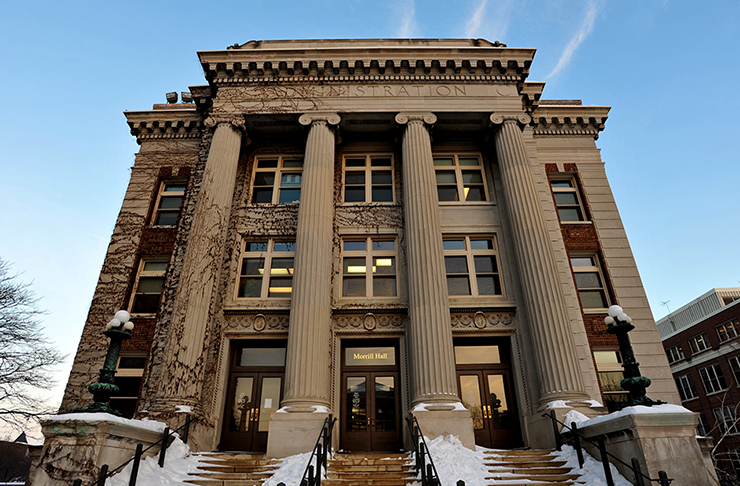
WASHINGTON — Even as Abraham Lincoln was embroiled in the Civil War in 1862, he pressed Congress to approve a law that would establish a series of what were eventually known as “land grant” colleges in an effort to propel the nation forward.
Lincoln’s actions resulted in an explosion of academic research in schools that produced the nation’s first vaccines and astounding developments in agriculture, among other great academic achievements. But the establishment of these schools continues to create tensions between Native American tribes and what are now some of the largest U.S. universities because the land was seized outright or taken through forced sales that ignored the true value of the land. That’s prompted the nation’s tribes to seek reparations from what is now derided as “land grab” universities.
Minnesota’s 11 tribes are among those seeking compensation for the land that is now a great part of the University of Minnesota’s holdings. And the university is grappling with what it can do to make amends. On Wednesday, Karen Diver, the university’s senior adviser on Native American affairs, made her annual report to the school’s regents.
She said allowing tribes to benefit from the massive Permanent University Fund, which includes the money the school makes on mineral leasing, sales and mineral royalties, was one recommendation. The Permanent University Fund in 2020 totaled more than $591 million. “Taconite shares” held by the university could also play a part, Diver said.
“What do reparations look like?” Diver asked. “These aren’t payments to Native Americans or to tribes, but it is how do we look at our resources? … How do we look at revenue and how do we make sure Native Americans are beneficiaries?”
While the University of Minnesota, along with other land grant colleges, are trying to address a history of toxic relationships with the nation’s tribes, progress has often been difficult and slow.
Diver, a former Fond du Lac Tribal chairwoman and former Obama administration Native American affairs adviser, was hired by the University of Minnesota in 2021 to help the school try to redress injustices and strengthen relationships with Minnesota’s tribal nations. She acknowledged that full reconciliation would take time.
“Tribes understand that this is generational, institutional work,” she said.
The legislation Lincoln signed into law in 1862, known as the Morrill Act, donated land to states and territories “which may provide colleges for the benefit of agriculture and the mechanical arts.” Each state was given 30,000 acres for each senator and member of the U.S. House in its congressional delegation. The result was that about 10.7 million acres of land was expropriated from 245 tribes after Morrill Act was implemented.
The federal government acquired Morrill Act lands through treaties, executive orders and in some cases without any sort of treaty or agreement whatsoever. Since the U.S. military was involved in the land transfers, there was frequent violence, when Indigenous peoples were expelled so the land grant schools could be established.
According to an investigation into Morrill Act’s transfer of land by High Country News, the University of Minnesota was given 94,631 acres, and the state’s tribes were paid $2,309 for the land.
The troubled history of the relationship between Minnesota’s Native Americans and the University of Minnesota was detailed in the TRUTH Report, released in April. The 600-page study by a team of Native scholars says it “details how the founding regents and the University of Minnesota have undermined Tribal sovereignty and Indigenous self-determination, using genocide, land expropriation, and exploitation of Indigenous knowledge systems to transfer and accumulate wealth.” The report also said the university “has participated in the development and teaching of revisionist narratives that conceal the systemic harms perpetuated against Indigenous peoples.”
One of the recommendations of the TRUTH Report is that the university give back or “rematriate,” Indigenous lands. The school is in the process of returning about 3,400 acres, the site of the Cloquet Forestry Center, to the Fond du Lac Band of Lake Superior Chippewa. The forestry center is wholly located within tribe’s reservation.
“It is on the top of our list and we are making progress,” Diver said of the land transfer.
She also said the university might consider “co-management” with tribes of some of its other “field sites.”
“That’s something that we could be discussing in the future,” Diver said.
The TRUTH Report also recommended “reparations in perpetuity” from the Permanent University Fund, “to Indigenous peoples.”
All 11 of the state’s Native American tribes have agreed to press for reparations. However, the tribes have not settled on a specific amount, partly because of the difficulty of quantifying all the harm done.
The TRUTH Report also called for more Native American representation in the administration, faculty, staff and students at all of the university’s campuses. And it called for the university to waive the full cost of attendance for all Indigenous students, regardless of from where they come.
Starting last fall, the university will offered Native American students whose family income is less than $125,000 a year free or reduced tuition. But it is limited to students who belong to one of Minnesota’s 11 federally recognized tribes and does not cover all expenses of attending the university.
This year, the state Legislature approved an $8.5 million program that is more generous. The state’s tuition assistance plan would pay all tuition and fees for Native Americans who live in Minnesota, so Diver said the university is changing its tuition assistance program so it also covers more of the costs of an education on its campuses.
The university is also in the process of returning Native American remains and funerary objects that were excavated in New Mexico nearly a century ago by the school’s anthropology students and were placed on display for decades in its anthropology department and the Weisman Art Museum. Diver told the regents that the Hopi tribe has agreed to take the lead in assuming possession of the remains and funerary artifacts from several Southwestern tribes because “they have the best capacity.”
Diver said the university is also taking other steps, including funding a Ph.D. program for Native American studies and developing a new Office of Native American Affairs website to consolidate Native American research and tribal information.
The University of Minnesota’s new interim president, former Hormel chief Jeff Ettinger, plans to meet with tribal leaders in the fall. Ettinger has also been tasked by the university’s board of directors to come up with official recommendations in response to the TRUTH Report. The recommendations are expected later this year.
Despite the devastating findings of the report, it is optimistic that a path to reconciliation with the university can be forged.
“We still see that higher education is currently a valuable path for our people and also believe it doesn’t have to be so difficult to be Indigenous in education systems,” the report said. “We can find common ground and create more success for Native Americans in higher education.”


